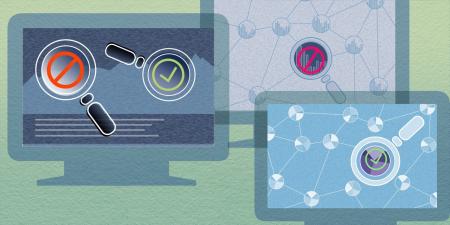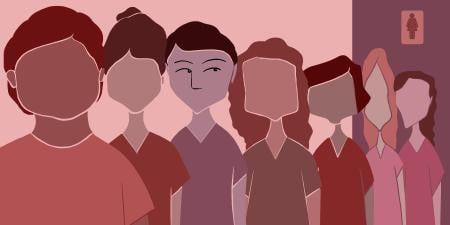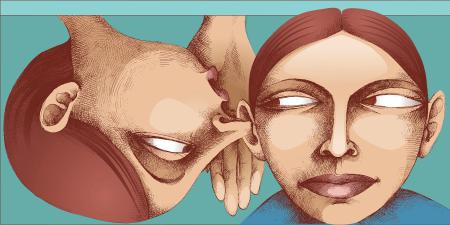Abstract
False beliefs in medicine can be regulated by constitutional doctrines of false speech and professional speech, whereby government can restrict professionals’ false beliefs or impose its own false beliefs on professionals. In our allegedly “post truth” society, such regulations and their foundations can have an important influence on health care practice.
False Beliefs and Health Care
There has been a resurgence of false beliefs in American society. These false beliefs range from scientific in nature, such as the “flat-earth” paradigm1; to the politically motivated and influenced, such as the “birther” movement2; to the conspiratorial, such as claims that the moon landings were an elaborate hoax.3,4 False beliefs have also found their way into health care, sometimes with dire consequences. For example, false beliefs about cures for AIDS have long been problematic5; another example is the anti-vaccine beliefs of Somali and Orthodox Jewish communities to which recent measles outbreaks in Minnesota and Los Angeles have been attributed.6,7
What happens when health care professionals are sources of false beliefs that influence their practices, patients’ care, and public health? How can government regulate clinicians’ false beliefs? What if government itself is a source of false belief and compels clinicians to express these beliefs to patients? In this article, I explore these questions from the perspective of American jurisprudence, which, for this issue, is nominally First Amendment constitutional law governing freedom of speech.8
Government Regulation of Clinicians in the Speech Context
Clinicians are not free to practice without limitations from the government. Health care practice engages constitutional speech, so regulations on clinicians’ conduct and practice can be viewed as limitations on their freedom of speech. Although clinician speech on its face is less obvious than speech seen in other more verbally intensive professions, such as the practice of law, when a clinician advises a patient, she is engaging in speech.9 Viewed through the lens of First Amendment jurisprudence, there are broadly 2 different categories of speech relevant to adjudicating laws and regulations governing clinicians’ practices: false speech and professional speech.
False speech. False speech is a category of law wherein government regulates and sanctions false statements. Some categories of false statements include fraud, defamation, perjury, and false commercial speech.10 Government authority to regulate false speech is founded in the squaring of law and morality, which resulted in generally accepted ethical prohibitions against falsehoods being incorporated in the legal sphere.11 A false statement may be impermissible under regulations or statutes, but there are limitations on government’s authority to restrict false speech. The Supreme Court has repeatedly recognized that falsity alone is not enough to warrant regulation and that there must be some extenuated circumstance attached to the falsity—like malice or perjury, for example—for government sanction of false speech to be valid.12-14
In the context of health care, consider the situation of a clinician practicing with a false belief—such as the belief that vaccines cause autism—who counsels patients against receiving vaccines. This belief is counter to established evidence-based medicine and causes appreciable harm. For this reason, some legal scholars note that true and false speech regarding scientific facts—such as what might be exchanged during a clinical encounter, for example—should be separate First Amendment speech categories, thereby allowing greater regulation of false scientific speech.12,15 Scientific speech is different from other kinds of false speech because of the nature of evidence-based logic; that is, it is easier to determine which statements are actually true or false. As Christopher Guzelian explains, “false scientific speech meets the predictable definition of false speech better than other forms of speech because the speech’s falsity is knowable.”12 Currently, constitutional law that restricts false speech does not take into account this unique aspect of scientific speech—that its truth is verifiable—and is instead a patchwork of rules and standards, such as the standard that public officials must demonstrate that false statements were made with “actual malice” in order to prevail in a defamation suit.13 This hodgepodge of rules and standards creates unpredictability in determining false-speech liability.12 Hence, Guzelian argues that scientific speech (which would be largely applicable to health care practice because of the profession’s scientific underpinnings), because of its “knowable” character, should be subject to additional scrutiny and evidentiary standards relative to other forms of false speech (like defamation), thus enabling false scientific speech to be held to account and its liability to be predictable.12
Professional speech. As opposed to the more general doctrine of false speech, professional speech is directly related to clinicians’ speech, and there is an existing body of case law involving physicians. Claudia Haupt describes professional speech as communication of “insights through the professional to the client, within a professional-client relationship.”16 A defined professional speech doctrine has not yet been articulated by the Supreme Court, and the degree of First Amendment protection for professional speech currently remains undeveloped and is provisional in nature.17-19 While the legal contours of a professional speech doctrine are unclear, there is a body of cases relating to the professional speech of a range of groups, from traditional professionals—such as physicians, nurses, pharmacists, and lawyers—to quasi-professionals, such as fortune tellers.20,21
Professional speech cases relevant to clinicians fall into 2 common types. First, there are the cases in which government imposes a strict ban or limit on certain practices of clinicians, circumscribing how they may practice their profession. This is the most straightforward way government can restrict a professional’s practice. Famous recent examples are the homosexual conversion therapy bans in California and New Jersey. These bans, fundamentally identical in both states, outlawed any clinician from engaging in “reparative” therapies for homosexual minor patients.19,22,23 Notably, the courts in both cases differed on whether the ban was regulating the “speech” or “conduct” of the therapist, illustrating the debate about whether a clinician’s practice is considered speech. The bans were challenged by professionals in both states, who argued that such bans violated their First Amendment freedom of speech rights. The California case went to the 9th Circuit Court of Appeals, where the ban was ultimately upheld in Pickup v Brown; the Court upheld the ban as a constitutional restriction on the professional’s conduct and did not view the ban as a limit on professional speech.22 In New Jersey, the case went to the 3rd Circuit Court of Appeals, where, in King v Governor of New Jersey, the Court upheld the ban but, differing from the 9th Circuit, viewed the ban as a restriction on professional speech, which is subjected to a higher level of scrutiny.23 As Timothy Zwick explains, the 3rd Circuit reasoned that the “ban was permissible only if it directly advances the state’s substantial interest in protecting minor clients and is not more extensive than necessary to serve that purpose.”19 The 3rd Circuit explained that “the reason professional speech receives diminished protection under the First Amendment [is] because of the State’s longstanding authority to protect its citizens from ineffective or harmful professional practices.”23 The Court further explained that the validity of New Jersey’s conversion therapy ban (ie, the validity of a state’s ability to restrict professional speech) should be reviewed with a level of scrutiny such that the New Jersey legislature, in its attempt to protect its citizens from harmful and ineffective professional practices, has “drawn reasonable inferences based on substantial evidence.”23 The 3rd Circuit ultimately found that the New Jersey legislature met this burden, as there was substantial evidence in the legislative record that conversion therapy was both harmful and ineffective.23 King demonstrates that such bans on professional speech, when weighed against free speech rights of health professionals, can (and should) survive constitutional scrutiny.23
The second common type of case regarding physician professional speech is compelled speech, in which the government compels clinicians to express its viewpoint. A classic example of how the state compels professional speech is mandatory ultrasound laws or other similarly penned laws designed to thwart abortion. Many of these laws came after the Supreme Court’s ruling in Planned Parenthood of Southeastern Pennsylvania v Casey, which challenged Pennsylvania law requiring disclosure of medical information and alternatives to abortion at least 24 hours before the abortion was performed.24 David Orentlicher explains that the Supreme Court upheld the law in this case “on the grounds that [Pennsylvania] mandated information that was truthful and nonmisleading and that would make for a fully informed decision by the woman.”25 In this sense, the restriction, though ideologically motivated, was constitutionally valid as a codification of lawful informed consent goals. As Orentlicher notes, “the state need not remain neutral, but was free to promote an interest in the preservation of fetal life, as long as its speech mandates were truthful and not misleading.”25 Another case involving compelled speech is Planned Parenthood Minnesota, North Dakota, South Dakota v Rounds, wherein a 3-judge panel on the 8th Circuit struck down an abortion informed consent statute that compelled clinicians to inform patients that women who have an abortion have an increased risk of suicide.26 The panel noted that no studies or evidence supported an increased risk of suicide and concluded that such a statute “violates doctors’ First Amendment right to be free from compelled speech that is untruthful, misleading, or irrelevant.”26 The panel’s decision was eventually overturned by an en banc decision by the 8th Circuit,27 but Orentlicher argues that the 3-judge panel got its decision correct, as informed consent mandates “must be truthful and not be misleading [and t]he goal is to inform not misinform.”25 Therefore, in an ideal sense, truthfulness of speech is key for constitutional validity of statutes that compel speech of health professionals. Courts are wise to follow the truthfulness standard set by the Supreme Court in Casey, as it allows a clinician to further, rather than hinder, patients making “wise” and “informed” decisions,24 while a “compelled medical statement that contradicts in unequivocal terms the leading associations of experts in relevant fields does not serve that end.”26
Discussion
The battles over restricting clinician speech related to the false beliefs of either clinicians or government become more controversial and high profile when the speech act in question is related to a politicized issue, such as conversion therapy or abortion. However, not all cases of false beliefs in health care are of this type. For example, as noted by Steven Woolf, “[p]hysicians are not immune to false beliefs about clinical efficacy”; studies have shown that “patients, clinicians, and society often hold unrealistic expectations about the effectiveness of tests and treatments,” thus creating an “appetite for procedures of dubious effectiveness.”28 In such instances, the forces that help perpetuate the false belief are not so much political as they are economic or psychological.28
Additionally, it is important to remember that history has shown that some accepted norms in health care are products of incorrect conclusions that were later found to be wrong. A famous example is the long-held notion that stomach ulcers were caused by stress and anxiety. This notion was refuted by Australian scientists Barry Marshall and Robin Warren, who proved that ulcers are actually caused by an H pylori bacterial infection, not stress.29This example serves as a reminder that sometimes clinicians and the medical community get things wrong and that incorrect notions can become, for a time, established norms. In other words, today’s established norms (or false beliefs) may become tomorrow’s false beliefs (or established norms).
Critics of restrictions on clinician speech might point to the H pylori case as a cautionary tale in that what is currently deemed a false belief could actually be true. For example, if a physician treating a patient’s ulcer before the H pylori discovery had believed in a bacterial cause of stomach ulcers and decided to treat the patient using antibiotics, while eschewing any treatment related to stress or anxiety, such treatment would have been deemed based on a false belief that was not backed by the scientific community. Such a physician would have been providing, at the time, a medically unsupported treatment that would someday become universally supported by the medical profession; the physician would in actuality be a pioneer. In such a scenario, one might argue that any law or regulation that would bar or limit the physician’s practice and speech would be unjust and indicative of the hazards of limiting a physician’s speech, as doing so could stifle new practice knowledge that is legitimate and necessary.
While the risk of stifled truth always exists, reducing that risk is a joint responsibility of the medical profession and the government. The medical profession needs to continually strive for evidence-based guidelines, and the government should ideally follow and apply the profession’s collective wisdom founded on evidence-based knowledge. The government can accomplish this goal via the legislative and executive branches creating laws and regulations that restrict false professional speech and via the judicial branch adequately upholding and applying such rules while striking down or limiting improper ones.
When considering restrictions on scientific speech (like medical speech), larger questions come into view: Is false scientific speech always harmful? Might there be some false scientific speech that is not harmful? The answer is that false scientific speech of professionals is always harmful. This is because, as Claudia Haupt explains, professions are “knowledge communities,” meaning that professions are a “network of individuals who share common knowledge and experience as a result of training and practice” and are “engaged in solving similar problems by drawing on a shared reservoir of knowledge, which, at the same time, they help define and to which they contribute.”9 If knowledge upon which a profession builds its foundation is flawed or incorrect, then the profession cannot perform its services to society as intended. This is especially true of the scientifically based professions, like medicine, wherein the foundational knowledge is biologically based science. If the medical professional is operating under false scientific principles, the result is harmful; at best, the resultant flawed treatments will be ineffective, at worst, such flawed treatments can directly injure patients.
The uniqueness of scientific knowledge is such that, as long as rigorous scientific method is continually applied to test hypotheses, past misunderstandings—such as the belief that stomach ulcers are stress induced—can be resolved. Scientific knowledge is thus more likely than other types of information debated as false speech to reflect ultimate truths and falsehoods.12 Pursuit of truth is fundamental in health care; the state should regulate clinicians’ false beliefs, just as the state should not compel its own false speech through clinicians.
Summary
In an era of numerous false beliefs in society and in medicine, it is important to understand how false beliefs can be regulated. False beliefs that exist in medicine can be regulated by 2 legal doctrines: false speech and professional speech. The false speech doctrine is based on an analysis of the constitutionality of government restrictions on false statements. The professional speech doctrine is based on an analysis of the constitutionality of laws that may either restrict or compel the speech of professionals. Ultimately, a legal doctrine that allows a clinician to speak most truthfully to patients and the community is the best outcome for the health professions and society.
References
-
Poole S. Why bad ideas refuse to die. Guardian. June 28, 2016. https://www.theguardian.com/science/2016/jun/28/why-bad-ideas-refuse-die. Accessed March 30, 2018.
-
Robertson L. Indeed, born in the USA. FactCheck.org. https://www.factcheck.org/2011/04/indeed-born-in-the-u-s-a/. Published April 27, 2011. Accessed March 30, 2018.
-
Davis S. How do we know the moon landing really happened? National Space Centre Blog. June 16, 2017. https://spacecentre.co.uk/blog-post/know-moon-landing-really-happened/. Accessed March 30, 2018.
-
van der Linden S. Moon landing faked!!!—Why people believe in conspiracy theories. Scientific American. April 30, 2013. https://www.scientificamerican.com/article/moon-landing-faked-why-people-believe-conspiracy-theories/. Accessed March 30, 2018.
-
Brink S. Fake cures for AIDS have a long and dreadful history. NPR. August 17, 2014. https://www.npr.org/sections/goatsandsoda/2014/07/15/331677282/fake-cures-for-aids-have-a-long-and-dreadful-history. Accessed March 30, 2018.
-
Belluz J. Minnesota’s measles outbreak is what happens when anti-vaxxers target immigrants. Vox. October 26, 2017. https://www.vox.com/science-and-health/2017/10/26/16552864/minnesotas-measles-outbreak-immigrants-anti-vaxxers. Accessed on March 30, 2018.
-
Karlamangla S. Measles outbreak grows in LA’s orthodox Jewish community despite California’s strict new vaccination law. LA Times. January 21, 2017. http://www.latimes.com/local/california/la-me-ln-measles-20170120-story.html. Accessed on June 25, 2018.
-
US Const amend I.
- Haupt CE. Professional speech. Yale Law J. 2016;125(5):1238-1303.
- Guzelian CP. False speech: quagmire?. San Diego Law Rev. 2014;51(1):19-80.
- Goodman DR. Ethical falsehood: towards a moral values paradigm in false-speech adjudication. South Texas Law Rev. 2013;55(1):71-112.
- Guzelian CP. True and false speech. Boston Coll Law Rev. 2010;51(3):669-718.
-
New York Times v Sullivan, 376 US 254 (1964).
-
US v Alvarez, 567 US 709 (2012).
-
Guzelian CP. Scientific speech. Iowa Law Rev. 2008;93:881-928.
-
Haupt CE. Professional speech and the content neutrality trap. Yale Law J. 2017;127:150-172.
- Keighley JM. Physician speech and mandatory ultrasound laws: the First Amendment’s limit on compelled ideological speech. Cardozo Law Rev. 2013;34(6):2347-2405.
-
Smolla RA. Professional speech and the First Amendment. West VA Law Rev. 2016;119:67-112.
- Zwick T. Professional rights speech. Ariz State Law J. 2015;47(4):1289-1360.
- Jones NB. Did the fortune tellers see this coming? Spiritual counseling, professional speech, and the First Amendment. Miss Law J. 2014;83(3):639-670.
-
Moore-King v County of Chesterfield, 708 F3d 560 (4th Cir 2013).
-
Pickup v Brown, 740 F3d 1208 (9th Cir 2014).
-
King v Governor of New Jersey, 767 F3d 216 (3rd Cir 2014).
-
Planned Parenthood v Casey, 505 US 833 (1992).
- Orentlicher D. Abortion and compelled physician speech. J Law Med Ethics. 2015;43(1):9-21.
-
Planned Parenthood Minn, ND, SD vs Rounds, 653 F3d 662 (8th Cir 2011).
-
Planned Parenthood Minn, ND, SD vs Rounds, 686 F3d 889 (8th Cir 2012).
- Woolf SH. The price of false beliefs: unrealistic expectations as a contributor to the health care crisis. Ann Fam Med. 2012;10(6):491-494.
- Abbasi J. Barry Marshall, MD: H pylori 35 years later. JAMA. 2017;317(14):1400-1402.



